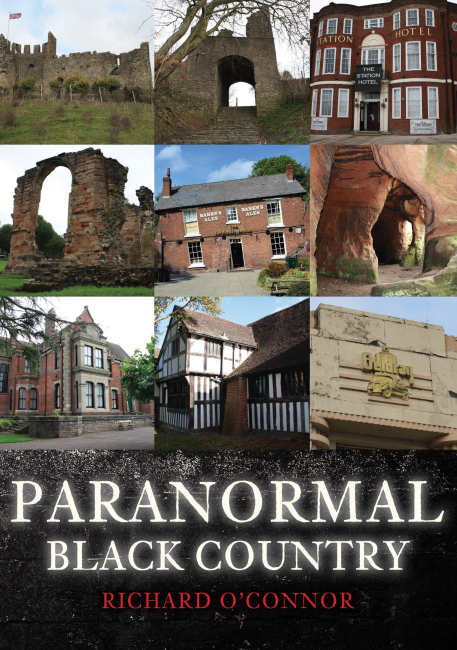
Reviewed by John Tate
Reviewing this little book has been a real pleasure. I write as a Black Countryman through and through, having spent the bulk of my eighty years living in this fascinating part of England and am intimately acquainted with a number of the locations featured. Paranormal Black Country is a real gem and should prove to be a very useful addition to the ghostly lore of a region steeped in rich history, much of which is covered in this lavishly illustrated and well written work.
A lot is packed into its ninety-three pages. Material is organised into four sections, each covering a modern local authority area, a simple and straightforward approach. The book begins with Dudley, moving on to Sandwell, Walsall and Wolverhampton. Within each of these are listed different locations, for example, for Dudley there is the Castle and Zoo, the well known Station Hotel, The Prior Ruins, Himley Hall, Holbeche House, the Crooked House of blessed memory and Kinver. This latter is in South Staffordshire, not Dudley, but presumably it had to fit in somewhere!
It is worth mentioning geography and cultural factors here. The Black Country is proud of its heritage, even if the BBC continues to confuse it with Birmingham. The Industrial Revolution which eventually changed the world began here, for better or for worse. Indeed the use of coal in iron production, pioneered by Dud Dudley, was developed in the valley of the River Stour. Many locals consider that the whole area should be a United Nations World Heritage Site. So where is the Black Country? Richard O’Connor’s definition is as good as any, but purists, of which this writer is one, insist that the thirty foot coal seam is a better measure. The coal seam extends to just beyond the Clent Hills in the District of Bromsgrove which means that the well attested haunting of places such as the Gypsy’s Tent pub* are sadly excluded from consideration.
That said, there is a wealth of information in the book. It is easy to read and the illustrations, most of which are presumably attributed to the author, bring the text very much alive. The absence of an index is a minor quibble, compensated for by a very useful bibliography, more on this later. Let me give a few highlights drawing on my own local knowledge as a means of focusing on to selected parts of the contents to give a flavour of what is written.
The following concentrates mainly on Dudley. There is a lot of pure history here, which is fascinating in its own right, backed up by very useful illustrations. The town is dominated by its castle which is famous for its ghosts. The ruins are well trodden by ’paranormal investigators’ and I can add my own tuppence worth here, or rather my daughter can! On a ghost hunt organised by her office, Natalie experienced a sudden pressure on her shoulders which slowly increased until she was virtually forced on to her knees before it suddenly vanished. Her compatriots wondered what on earth was happening to her, thinking that she had been taken ill. Natalie and her partner later spent a night at the (in)famous Station Hotel but drew a blank ghost-wise!
Next is Himley Lake, beloved by local anglers. As an angler who has the habit of turning up at the lake in the early morning and has been doing so for decades, neither I nor my fellows have experienced anything unusual but maybe we have never been sufficiently awake to notice! This whole location however seems to be something of a paranormal ’hot spot’ since the remains of the late lamented Crooked House Pub lie just over the eastern boundary of the Estate and to the south, literally just around the corner on the main A449 road, lies the now sadly empty Holbeche House. The story of Gideon Grove is well known, the incident(s) actually occurring on the A449. I first came across the story in a little book entitled Black County Ghosts and Mysteries written by the appropriately named Aristotle Tump (1987). I am a little surprised that this intriguing work is not listed in the bibliography. The remains of the Himley Woods still adorn the approach road to Himley Hall and the bog land that may still yet contain the corpse of the unfortunate Gideon is still apparent.
Let me add to this story. On page 26, there is an illustration of the ghost of what appears to be a raggedly dressed soldier caught in the headlights of a car. The source of the illustration is unacknowledged, but I could throw light on the driver of the car! In January of 1984, my fishing mate David Hendry had not long left the A449 at Stourton in the early morning on his way to fish for roach on the River Severn at Arley. Dawn was breaking and, as he neared a dip in the road just before the Fox Inn, his headlights focused on to what appeared to be a cavalier standing in the middle of his lane. Dave flashed his headlights to no avail and in the end had to drive on the opposite side of the road to avoid the figure! As he passed, the apparition, if that is what it was, turned and looked at him! He was quite shaken up and afterwards wrote an account of the event in his fishing column in the Dudley News (see Tate, 2007, pp. 182-185). There was an immediate response with a number of supporting telephone calls and letters. One witness, a lady, had subsequently researched the locality. She found details of a skirmish following the Battle of Worcester in 1651, close to the location in nearby Stourton in which a number of cavaliers met their end. These events post-date the gunpowder plot by not far off one hundred and fifty years – is the A449 a haunted hot spot that may be still be active today? I must show Dave the page 26 illustration!
Kinver. What a lovely village, now a dormitory settlement for the well heeled working elsewhere in the conurbation. The book does great justice in describing its history with some appropriate illustrations which really bring the text to life. Although many of this reviewer’s family happily inhabit the place, there are some ghostly stories that we were unaware of. The Rock Houses and Gibbet Lane are fascinating places, but I would not like to visit alone after dark! One omission is any mention of the Drakelow Tunnels under nearby Kingsford Country Park, beloved of ’paranormal investigators’.
The coverage of Sandwell is similarly stimulating. I live within easy walking distance of Haden Hill Park and House and knows the place well. Again, great history, photographs and ghost stories! However, O’Connor fails to mention the visit of the “Most Haunted” team to the location, which is probably just as well since a follow-up visit by my wife and I may have been instructive. The TV people seemed to have some remarkable experiences in the extensive cellar complex and the Friends Team was happy to let us explore. Of course nothing happened. When informed of this, the Friends simply said “we are not saying anything”. Make of this what you will.
Other than the Oak House, I am less familiar with the other locations in Sandwell covered, but mention must be made of Whiteheath with the story of Dawn and Mike Green. There may be another set of events worth mentioning in relation to Whiteheath as well. Here I must return to Aristotle Tump’s little book again. In the Chapter entitled The Ghost Tapes: A Tale of Voices From Beyond the Grave there is a story about Whiteheath concerning the McCarthy family who lived in Winwood Road. An ordinary cassette tape had suddenly started to play crashing noises, the groans of a man seemingly in agony and the whimpering of a young lad in terror. It turned out that the McCarthy’s house was on the site of the old Black Bat Colliery which had suffered a devastating explosion in the mid 1800s resulting in many deaths, including those of children. Food for thought? There is more to this story but I will leave it there.
After Sandwell, the book tends to fade out somewhat. Did the author run out of steam or does his exposition simply reflect the paucity of information available? Nonetheless, the theme continues and there are some fine ghostly stories contained therein. For example, the story of the barn owl in the Beldray building in Wolverhampton is a good one!
Coal extraction, chain making, metal bashing, and even glass production may be almost things of the past but new economic activity is being spawned as replacement, namely tourism. The region’s rich history is now being turned into a money spinner with Dudley Zoo and the Black Country Living Museum playing a lead part. In addition, many of the places highlighted in this book are well worth a visit which means that, essentially, the work is a tourist guide with a paranormal theme which should play a small part in this regeneration process. Some places featured, for example, the Station Hotel and Gibbet Lane, have featured on television. That said, there are clearly more paranormal stories yet to be told, as should be evident from what I have written. Notable locations are Oldnall between Hales Owen and Stourbridge, together with the Rowley Hills.
O’Connor is clearly aware of this and in his final piece mentions a second edition. Allow me to share an observation, not a criticism. The book hangs together very well but for the future what of UFOs? There is the story of the “Dudley Dorito”, a mysterious triangular object seen widely over the region in the late 2000s and early 2010s. Are UFOs paranormal? Many who call themselves ’ufologists’ would, I guess, answer in the positive, a perspective reinforced by events on the Rowley Hills on 4th January 1979 and involving the late Mrs Jean Hingley. This latter event is so bizarre as to border on the incredible (Tate, 2023).
So there we have it. A recent book giving a good, refreshing airing to a fascinating subject. I congratulate Richard O’Connor for his efforts. For anyone interested in the Black Country and its history this work is a welcome addition to the literature; for anyone with an interest in the paranormal it is a must. There has to be a follow-up and soon! One final point. The wonderful tinted sketches that add so much to the exposition are unsourced. This is a shame as whoever produced them has done a fine job. Was it the author himself or someone else? Whoever it is, their work needs to be recognised.
*Now called “The Badger’s Set”, the hauntings of which has been publicised by Jayne Harris. The interference in the region’s history and culture by the large public house chains by changing the names of Black Country public houses is most annoying. Planning permission should be required!
References
Tate, J. (2007). Tales from a Worcestershire whirlpool. Athena Press.
Tate, J. (2023). Lights over the Rowley Hills. Seriously Strange Magazine [a publication of the Association for the Scientific Study of Anomalous Phenomena], (159).
Tump, A. (1987). Black country ghosts and mysteries. Bugle Publications.

